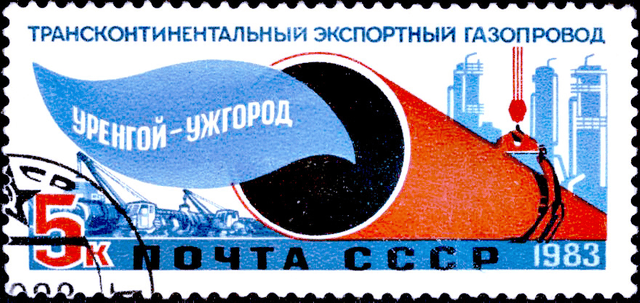Urengoy–Pomary–Uzhgorod pipeline

Urengoy–Pomary–Uzhgorod pipeline

| Urengoy–Pomary–Uzhgorod pipeline | |
|---|---|
| Location | |
| Country | Russia, Ukraine |
| General direction | north-south-west |
| From | Urengoy gas field |
| Passes through | Izhevsk, Yelets, Kursk, Romny, Zhmerynka, Bohorodchany, Ivano-Frankivsk |
| To | Uzhhorod |
| Runs alongside | Progress pipeline, Soyuz pipeline, Bratstvo pipeline |
| General information | |
| Type | natural gas |
| Operator | Gazprom UkrTransGaz |
| Commissioned | 1984 |
| Technical information | |
| Length | 4,500 km (2,800 mi) |
| Maximum discharge | 32×10 |
The Urengoy–Pomary–Uzhhorod pipeline (also known as the West-Siberian Pipeline, or Trans-Siberian Pipeline) is one of Russia's main natural gas export pipelines, partially owned and operated by Ukraine.
| Urengoy–Pomary–Uzhgorod pipeline | |
|---|---|
| Location | |
| Country | Russia, Ukraine |
| General direction | north-south-west |
| From | Urengoy gas field |
| Passes through | Izhevsk, Yelets, Kursk, Romny, Zhmerynka, Bohorodchany, Ivano-Frankivsk |
| To | Uzhhorod |
| Runs alongside | Progress pipeline, Soyuz pipeline, Bratstvo pipeline |
| General information | |
| Type | natural gas |
| Operator | Gazprom UkrTransGaz |
| Commissioned | 1984 |
| Technical information | |
| Length | 4,500 km (2,800 mi) |
| Maximum discharge | 32×10 |
History
The pipeline project was proposed in 1978 as an export pipeline from Yamburg gas field, but was later changed to the pipeline from Urengoy field, which was already in use. In July 1981, a consortium of German banks, led by Deutsche Bank, and the AKA Ausfuhrkredit GmbH agreed to provide 3.4 billion Deutsche Mark in credits for the compressor stations. Later finance agreements were negotiated with a group of French banks and the Japan Export-Import Bank (JEXIM). In 1981-1982, contracts were signed with compressors and pipes suppliers Creusot-Loire, John Brown Engineering, Nuovo Pignone, AEG-Telefunken, Mannesmann, Dresser Industries, and Japan Steel Works. Pipe-layers were bought from Caterpillar Inc. and Komatsu.[1]
On 19 July 2011, UkrTransGaz started modernization of the pipeline.[3]
Route
The pipeline runs from Siberia's Urengoy gas field through compressor plant in Pomar, Mari El to Uzhhorod in Western Ukraine. From there, the natural gas is transported to Central and Western European countries.[4] Together with Soyuz and Progres pipelines it forms the western transit corridor in Ukraine.[5] It crosses the Russian–Ukrainian border north of Sumy. In Ukraine, it takes gas to the Uzhhorod pumping station on the Ukrainian border with Slovakia and to smaller pumping stations on the Hungarian and Romanian borders.[6] The pipeline crossed the Ural Carpathian mountains and more than 600 rivers including Ob, Volga, Don and Dnepr rivers.[7]
Technical features
The pipeline is 4,500 kilometres (2,800 mi) long, of which 1,160 kilometres (720 mi) is in Ukraine.[1][5] Its diameter is 56 inches (1,420 mm).[1] The original annual capacity of the pipeline was 32 billion cubic metres (1.1 trillion cubic feet) of natural gas per year.[1] By 2009, the factual annual capacity was 27.9 billion cubic metres (990 billion cubic feet).[5] It has 42 compressor stations, of which nine are in Ukraine.[1]
The telecommunications and cathodic protection systems of the pipeline were installed by Alcatel of France. The pipeline utilizes 85 dual CCTV stations for telecommunications.[8]
Operators
The Russian section of this pipeline is operated by Gazprom and the Ukrainian section is operated by UkrTransGaz.
Controversies
Disagreement among the allies
The Soviet plans to build the pipeline were strongly opposed by the Reagan administration.[9][10][11] Americans were afraid that Western Europe would become dependent on the Soviet gas supplies, giving an energy leverage to the Soviet Union. They also feared the Kremlin would use the export revenue for the military purposes.[12] In December 1981, the US implemented sanctions preventing American companies from exporting oil and gas technologies - necessary for the pipeline construction - to the Soviet Union. In June 1982, these sanctions were expanded to cover subsidiaries of US companies in Europe.[12]
Washington's Western European allies, however, refused to boycott the pipeline.[13][14] The foreign ministers of the European Economic Community called extension of the American sanctions illegal and sent a formal note of protest.[12] From the European perspective, participation in the pipeline project was seen as an opportunity for the depressed steel and engineering industry in Europe and as a way to diversify from the OPEC oil supplies.[12] Therefore Western European governments insisted that contracts already signed between the Soviets and European companies needed to be honored. This led to several European companies being sanctioned by the US.[15][16] Reagan reportedly said: "Well, they can have their damned pipeline. But not with American equipment and not with American technology."[17] The efforts by the US to prevent the construction of the pipeline, and its export embargo of supplies needed to build it (1980-84), constituted one of the most severe transatlantic crises of the Cold War.[16][18]
Forced labor
The construction of the pipeline was also subject to a United States Congressional hearing investigating the use of imported Vietnamese labor from re-education camps to build the pipeline.[19]
Accidents
The pipeline's first accident occurred even before the project began. On 15 December 1983, a fire broke out at a compressor station in Urengoy, destroying electronic monitoring devices and control panels, but no one was injured.[20]
A terrorist explosion damaged the pipeline in Rozhniativ district in Ivano-Frankivsk Oblast in May 2014.[24] According to the Russian government owned radio station Voice of Russia terrorist threats against the pipeline were made by Right Sector leader Dmytro Yarosh in March 2014.[25] Another section of the pipeline exploded in the Poltava region on June 17, 2014,[26] one day after Russia limited the supply of gas to Ukrainian customers due to non-payment. Ukraine's Interior Minister Arsen Avakov said the next day, that the explosion had been caused by a bomb.[27]
See also
Yamal-Europe pipeline
Natural gas transmission system of Ukraine